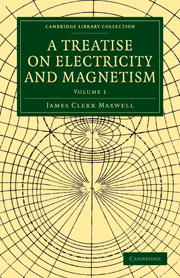Book contents
- Frontmatter
- PREFACE
- Contents
- ELECTRICITY AND MAGNETISM
- PRELIMINARY
- PART I ELECTROSTATICS
- PART II ELECTROKINEMATICS
- CHAPTER I THE ELECTRIC CURRENT
- CHAPTER II CONDUCTION AND RESISTANCE
- CHAPTER III ELECTROMOTIVE FORCE BETWEEN BODIES IN CONTACT
- CHAPTER IV ELECTROLYSIS
- CHAPTER V ELECTROLYTIC POLARIZATION
- CHAPTER VI MATHEMATICAL THEORY OF THE DISTRIBUTION OF ELECTRIC CURRENTS
- CHAPTER VII CONDUCTION IN THREE DIMENSIONS
- CHAPTER VIII RESISTANCE AND CONDUCTIVITY IN THREE DIMENSIONS
- CHAPTER IX CONDUCTION THROUGH HETEROGENEOUS MEDIA
- CHAPTER X CONDUCTION IN DIELECTRICS
- CHAPTER XI MEASUREMENT OF THE ELECTRIC RESISTANCE OF CONDUCTORS
- CHAPTER XII ELECTRIC RESISTANCE OF SUBSTANCES
- Plate section
CHAPTER I - THE ELECTRIC CURRENT
Published online by Cambridge University Press: 05 July 2011
- Frontmatter
- PREFACE
- Contents
- ELECTRICITY AND MAGNETISM
- PRELIMINARY
- PART I ELECTROSTATICS
- PART II ELECTROKINEMATICS
- CHAPTER I THE ELECTRIC CURRENT
- CHAPTER II CONDUCTION AND RESISTANCE
- CHAPTER III ELECTROMOTIVE FORCE BETWEEN BODIES IN CONTACT
- CHAPTER IV ELECTROLYSIS
- CHAPTER V ELECTROLYTIC POLARIZATION
- CHAPTER VI MATHEMATICAL THEORY OF THE DISTRIBUTION OF ELECTRIC CURRENTS
- CHAPTER VII CONDUCTION IN THREE DIMENSIONS
- CHAPTER VIII RESISTANCE AND CONDUCTIVITY IN THREE DIMENSIONS
- CHAPTER IX CONDUCTION THROUGH HETEROGENEOUS MEDIA
- CHAPTER X CONDUCTION IN DIELECTRICS
- CHAPTER XI MEASUREMENT OF THE ELECTRIC RESISTANCE OF CONDUCTORS
- CHAPTER XII ELECTRIC RESISTANCE OF SUBSTANCES
- Plate section
Summary
230.] We have seen, in Art. 45, that when a conductor is in electrical equilibrium the potential at every point of the conductor must be the same.
If two conductors A and B are charged with electricity so that the potential of A is higher than that of B, then, if they are put in communication by means of a metallic wire C touching both of them, part of the charge of A will be transferred to B, and the potentials of A and B will become in a very short time equalized.
231.] During this process certain phenomena are observed in the wire C, which are called the phenomena of the electric conflict or current.
The first of these phenomena is the transference of positive electrification from A to B and of negative electrification from B to A. This transference may be also effected in a slower manner by bringing a small insulated body into contact with A and B alternately. By this process, which we may call electrical convection, successive small portions of the electrification of each body are transferred to the other. In either case a certain quantity of electricity, or of the state of electrification, passes from one place to another along a certain path in the space between the bodies.
Whatever therefore may be our opinion of the nature of electricity, we must admit that the process which we have described constitutes a current of electricity.
- Type
- Chapter
- Information
- A Treatise on Electricity and Magnetism , pp. 288 - 294Publisher: Cambridge University PressPrint publication year: 2010First published in: 1873



